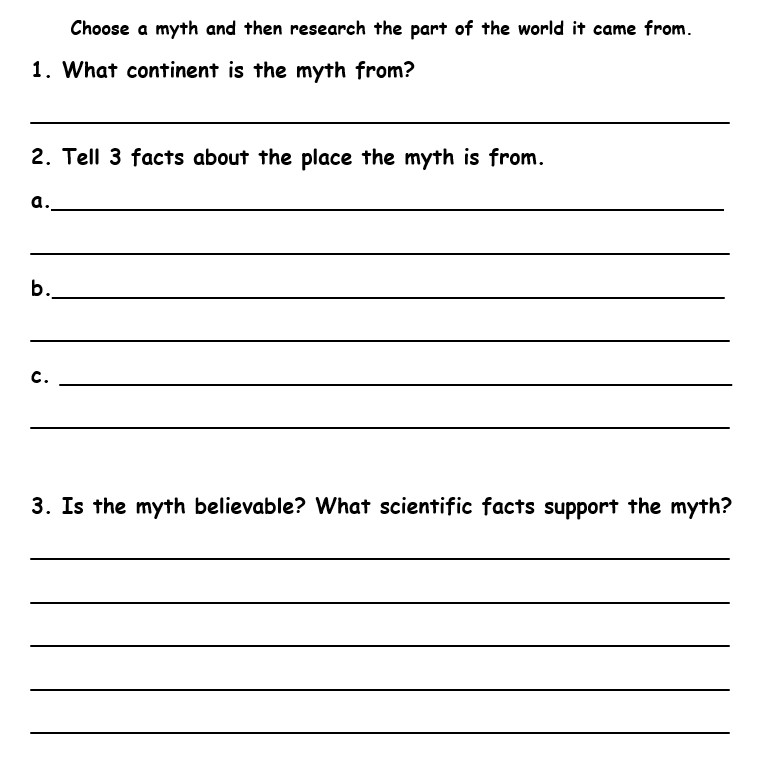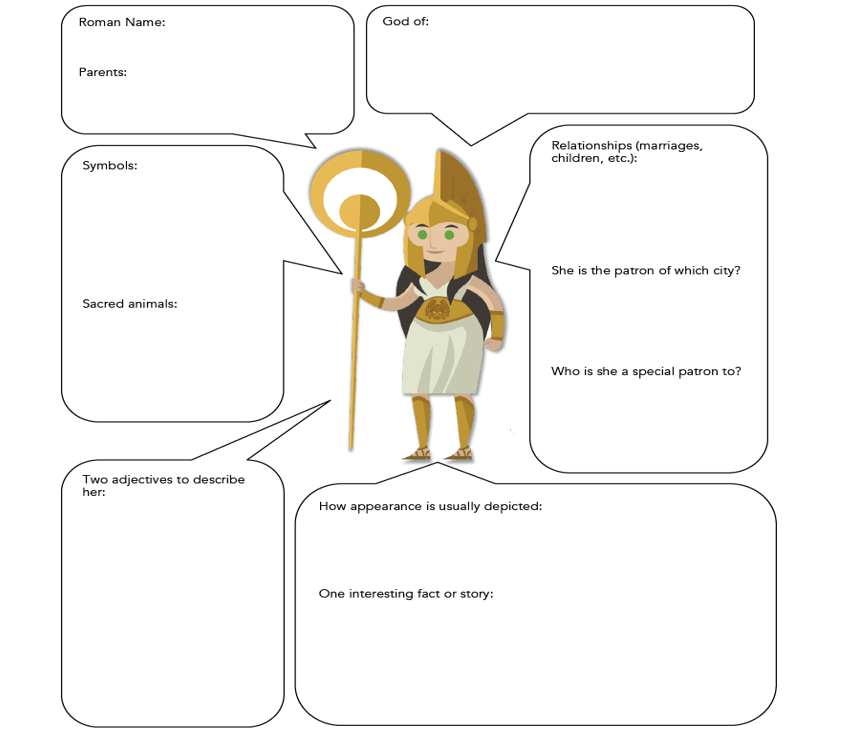Fantastic Folklore: Earthquake Myths
Myths
A myth is another type of traditional story that involves the early history of a culture. They are stories that answer and explain basic questions about the world. Myths are largely rooted in a religion or belief system and a strong reflection of the culture to where the myth originated. A fundamental element in every culture is a creation myth that explains how the wonders of the earth came to be. Some plots are based on something real, like a place, or a group of people that existed historically. However, a myth’s purpose is to explain a natural phenomenon, and often contains supernatural or fantastic beings, gods, and demigods. For example, Greek mythology originated to explain the seasons or weather while illustrating Greek culture and thinking.
Characteristics of Myths
- The author uses strong characterization or character traits are especially important; traits are revealed through appearance, actions, words, and what others think of them
- The characters must cope with aspects of human life: jealousy, love, death, ambition
- The character interact with gods and goddesses, and lesser deities, as well as humans
- Gods and goddesses have human emotions and extraordinary powers
- Many of the themes/lessons and symbols are still important in western culture today
Mythology is a collection of Myths. There are four types of Myths. They are
Animal Mythology, Creation Mythology, Hero Mythology, and Death or Underworld Mythology. You will be able to enjoy all these types of mythology in the weeks to come and complete some fun and engaging activities to go along with each type of mythology.
Creation Mythology
Creation Myths are stories that are symbolic to all cultures. They tell how things begin such as the universe, the earth, the earth’s inhabitants, or different aspects in nature came to be. Creation myths are an important basis of philosophy and religion. They often are considered sacred accounts and can be found in nearly all known religious traditions. They developed orally and therefore have several versions. Societies claim their creation myths to be factual and true.

Why are there Earthquakes? A creation Myth
Even with all the science and technology we have today, natural disasters still leaves us mystified. Just imagine experiencing an earthquake a thousand years ago. Would you ask how did this occur?
After experiencing a natural disaster, such as an earthquake, many cultures looked-for ways to explain how these natural disasters happened. The Greek culture was no different. The Greeks have many creation myths that explain how or why things happen.
In Greek Mythology, Poseidon was the god of the sea, son of Kronos and Rhea. Poseidon was known to be a god with a bad temper. Stories were told that when he became angry, he would hit the ground with his trident which caused earthquakes. He was given the Earthshaker. Stories are told of Poseidon striking the ground with this trident, which triggered earthquakes.
Below are other cultural myths about how earthquakes began. Information found on the US Geographical Survey. (https://www.usgs.gov/natural-hazards/earthquake-hazards/science/earthquake-legends?qt-science_center_objects=0#qt-science_center_objects)
American Indian
Once a Chickasaw chief was in love with a Choctaw princess. He was young and handsome, but he had a twisted foot, so his people called him Reelfoot. When the princess’ father refused to give Reelfoot his daughter’s hand, the chief and his friends kidnapped her and began to celebrate their marriage. The Great Spirit was angry and stomped his foot. The shock caused the Mississippi River to overflow its banks and drown the entire wedding party. (Reelfoot Lake, on the Tennessee side of the Mississippi River, was formed as a result of the New Madrid earthquake of 1812.)
Assam
There is a race of people living inside the Earth. From time to time they shake the ground to find out of anyone is still living on the surface. When children feel a quake, they shout “Alive, alive!” so the people inside the Earth will know they are there and stop the shaking. When people on Earth are very, very sinful, God sends an angry angel to strike the air that surrounds our planet. The blows produce a musical tone that is felt on the Earth as a series of shocks.
Colombia
When the Earth was first made, it rested firmly on three large beams of wood. But one day the god Chibchacum decided that it would be fun to see the plain of Bogota underwater. He flooded the land, and for his punishment he is forced to carry the world on his shoulders. Sometimes he’s angry and stomps, shaking the Earth.
East Africa
A giant fish carries a stone on his back. A cow stands on a stone, balancing the Earth on one of her horns. From time to time, her neck begins to ache, and she tosses the globe from one horn to the other.
Greece
According to Aristotle, and also to William Shakespeare in a play called Henry IV, strong, wild winds are trapped and held in caverns under the ground. They struggle to escape, and earthquakes are the result of their struggle.
India
The Earth is held up by four elephants that stand on the back of a turtle. The turtle is balanced on top of a cobra. When any of these animals move, the Earth trembles and shakes.
India
Seven serpents share the task of guarding the seven sections of the lowest heaven. The seven of them also take turns holding up the Earth. When one finishes its turn and another moves into place, people on the Earth may feel a jolt.
Japan
A great catfish, or namazu, lies curled up under the sea, with the islands of Japan resting on his back. A demigod, or daimyojin, holds a heavy stone over his head to keep him from moving. Once in a while, though, the daimyojin is distracted, the namazu moves, and the Earth trembles.
Latvia
A god named Drebkuhls carries the Earth in his arms as he walks through the heavens. When he’s having a bad day, he might handle his burden a little roughly. Then the Earth will feel the shaking.
Mexico
El Diablo, the devil, makes giant rips in the Earth from the inside. He and his devilish friends use the cracks when they want to come and stir up trouble on Earth.
Mongolia
The gods who made the Earth gave it to a frog to carry on his back. When this huge frog stirs, the Earth moves directly above the part of him that moves: hind foot, head, shoulder, or whatever.
Mozambique
The Earth is a living creature, and it has the same kinds of problems people have. Sometimes, it gets sick with fever and chills and we can feel its shaking.
New Zealand
Mother Earth has a child within her womb, the young god Ru. When he stretches and kicks as babies do, he causes earthquakes.
Romania
The world rests on the divine pillars of faith, hope and charity. When the deeds of human beings make one of the pillars weak, the Earth shakes.
Tennessee, U.S.A.
Once a Chickasaw chief was in love with a Choctaw princess. He was young and handsome, but he had a twisted foot, so his people called him Reelfoot. When the princess’ father refused to give Reelfoot his daughter’s hand, the chief and his friends kidnapped her and began to celebrate their marriage. The Great Spirit was angry, and stomped his foot. The shock caused the Mississippi to overflow its banks and drown the entire wedding party. (Reelfoot Lake, on the Tennessee side of the Mississippi, was actually formed as a result of the New Madrid earthquake of 1812.)
Scandinavia
The god Loki is being punished for the murder of his brother, Baldur. He is tied to a rock in an underground cave. Above his face is a serpent dripping poison, which Loki’s sister catches in a bowl. From time to time, she has to go away to empty the bowl. Then the poison falls on Loki’s face. He twists and wiggles to avoid it, and the ground shakes up above him.
Siberia
The Earth rests on a sled driven by a god named Tuli. The dogs who pull the sled have fleas. When they stop to scratch, the Earth shakes.
West Africa
The Earth is a flat disk, held up on one side by an enormous mountain and on the other by a giant. The giant’s wife holds up the sky. The Earth trembles when he stops to hug her.


Who was Poseidon?
Poseidon was the god of seas, horses, and earthquakes. He is the protector of all the waters, and widely worshiped by sea men. The horse is sacred to Poseidon, and myth says it is because he once mated with a horse (Demeter). In the beginning of Ancient Greece, Poseidon, Zeus and Hades chose from the realms of the world. Poseidon chose the water, Zeus the sky, and Hades the underworld. Poseidon’s weapon is the trident, and he uses it to shatter any object and shake the earth, therefore causing earthquakes. When these earthquakes happen, it is found that he is normally in bull-form, hence he was called “The Earth-shaking Bull.”
FUN FACTS
*Wherever Poseidon goes, he rides in a gold chariot drawn by two white horses with gold manes and brass hooves.
*Poseidon has a bad temper, is quick to anger, moody, unpredictable, greedy, difficult, and quarrelsome.
*Yet, he is creative, designing all the creatures in the sea.
*His parents are Cronus and Rhea.
*Poseidon is second only to Zeus in power among the gods, and he resents Zeus having the greater power.
*Poseidon had a series of fights with the other gods when he tried to take over their cities.
*Since Poseidon is the ruler of the seas; he is able to create storms and many shipwrecked voyages. Yet, he is also able to grant safety and safe voyages in the water.
*Poseidon has a beautiful underwater palace that he built for himself.
Research Poseidon and complete the speech bubbles below.


Flamingo Fun
The tall, graceful waterbirds keep astonishing scientists.
Something curious happened at the Smithsonian’s National Zoological Park in Washington, D.C. Early in the afternoon of August 23,2011, all 64 flamingos on exhibit suddenly rushed about before huddling together. They seemed to sense that something ominous was afoot.
It certainly was. Moments later, a magnitude 5.8 earthquake jostled the northeastern United States.
“It’s possible the flamingos were sensing some primary waves that the earthquake generated before the stronger waves that were felt by people,” says Felicity Arengo, a biologist at the American Museum of Natural History in New York. “In the wild, when a predator approaches, flamingos become alert and vocalize, and do tend to group together.”

Felicity Arengo
The Smithsonian incident was just the latest surprise that the elegant pink birds have held out for the scientists who observe them. “They are fascinating birds,” says Arengo.
Water Lovers
The only flamingos that most Americans ever encounter are lawn ornaments. Arengo didn’t see her first wild one until she was 29 years old, on a boat ride through a coastal lagoon in Mexico. “From a distance all I could see was a thin pink line on the water,” she recalls. “As we got closer I could see that it was a big group of flamingos standing very close to each other, feeding and making a lot of noise.”
Arengo was a graduate student at the State University of New York College of Environmental Science and Forestry. The trip to Mexico inspired her to make flamingos the focus of her research. “Once I started studying them, more and more questions came up,” she says.

Getty Images
An enormous flock of flamingos inhabits Lake Nakuru, one of several shallow, salty lakes in the Great Rift Valley of eastern Africa.
The Caribbean flamingos of Mexico are one of six flamingo species in the world. Members of that species also inhabit parts of southern Florida. Finding flamingos elsewhere in the world can be more challenging as some populations reside in remote locations and extreme environments, says Arengo. Flamingos have few problems with heat, cold, or altitude. “They look dainty but are actually very rugged,” she notes. In South America, flamingos live as high as 4,600 meters (about 15,000 feet) above sea level in the chilly heights of the Andes mountains. In Africa, an estimated 2.5 million flamingos—the world’s largest flamingo population—reside along the shoreline of Lake Natron. The temperature there can reach 50 degrees Celsius (about 120 degrees Fahrenheit).
One thing unites all flamingo habitats: water. Flamingos are waders—birds with long legs and long, pointed beaks that spend most of their time standing in shallow waters. Flamingos prefer salty water. Natron is a very salty, very shallow (1-meter-deep) lake.
Flamingos need water because they’re filter feeders—organisms that strain food like a sieve from the waters they inhabit. To feed, a flamingo turns its head upside down and dips it underwater. Rapidly waving its tongue back and forth, it pumps water into its bill, strains the food, and then flushes the water out.

Bill Gozansky/Alamy
A flamingo dips its beak into the water to feed.
Flamingos truly are what they eat. Their signature hue comes from chemicals that produce a pink pigment (coloring agent) in the invertebrates and algae that the birds subsist on. Researchers recently learned that flamingos also apply to their feathers a pink secretion from the uropygial gland, which is located under their tails. That “makeup” waterproofs the feathers and enhances their color, says Arengo, making the birds appear more attractive to mates.

Ben Mangor/SuperStock; Kevin Schafer/Corbis
Flamingos stand on one leg when it’s cold, hugging the other leg to their bodies for warmth, say researchers at St. Joseph’s University in Philadelphia. As the temperature drops, the leg rises.
Flash Mobs
Other than their color, what’s most striking about flamingos is their intensely social nature. They gather in flocks that can number in the tens of thousands. Such numbers offer the birds data and security. “When they are feeding, they may be gathering information from other flamingos about where the good places to feed are. Because their food is distributed in patches, many flamingos can feed in that patch. When the food runs out, they move as a group to another patch,” says Arengo. “There could also be safety in numbers. When they are in a group, the probability of one being singled out by a predator is lower.”
Groups of flamingos also engage in elaborate collective displays that look like the dance numbers on Glee. “The birds march together, flag their heads back and forth, do a ritualized false preening [grooming] behavior and a wing salute. It seems highly choreographed,” explains Arengo.
“Several flamingos will begin the initial behaviors. Others will join in, and they escalate and add other behaviors to the sequence.”
The routines are courtship rituals, says Arengo. Flamingos seem to be attracted to others whose movements are similar to their own.
Shy Of Humans
Arengo admits that flamingos can be difficult to study. “They are quite sensitive to human disturbance,” she says. “You can’t walk among them. If you get too close, they will walk away and even fly.”
Still, they never stop intriguing her: “Why do they choose to feed in a particular place? How long do they stay there? And when do they move to find another location?”
Then there’s the simple pleasure of observing such beautiful animals. “Every time I see them, I’m absolutely amazed,” Arengo says. “They’re the coolest-looking bird in the world.”
Copyright © 2009 Weekly Reader Corporation. All rights reserved. Used by permission.
Weekly Reader is a registered trademark of Weekly Reader Corporation.
All About Earthquakes
Make an Earthquake Resistant Gingerbread House
https://www.thespruceeats.com/royal-icing-recipe-for-decorating-cookies-995181

